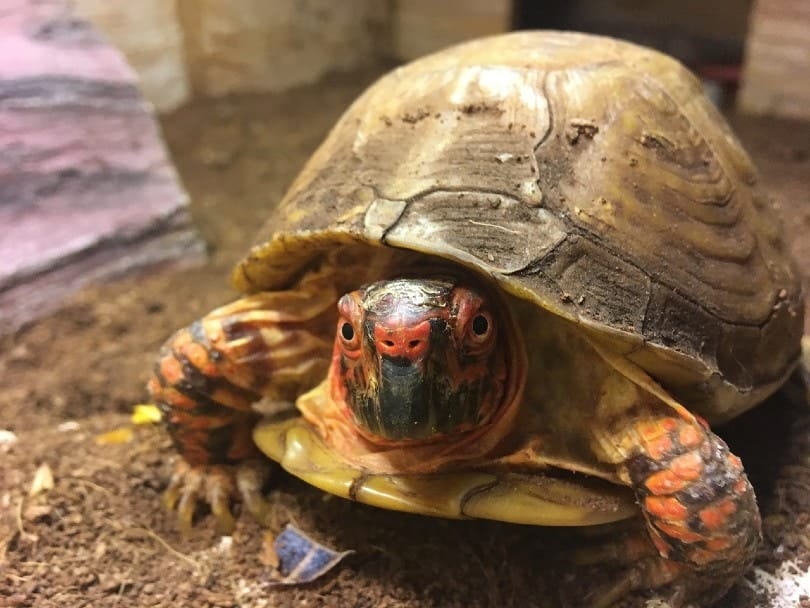The Three-toed Box Turtle is just that, an eastern box turtle that almost always has just three toes on its hind feet!
Shy and quiet are the traits of a Three-toed Box Turtle, both in its personality and in its coloring. Unlike the bold patterning and color seen on other eastern box turtles, the color of this species is quite subdued. Occasionally there will be a Three-toed that is more brightly colored, but for the most part they are a fairly uniform olive-brown to brown or horn color.
These wonderful animals are also small, gentle, and don’t bite. They may seem like a desirable pet, however there are a few things to keep in mind before acquiring a box turtle. Box turtles are solitary creatures and do not need companions. They need to be protected from other household pets, such as a dog. They are sensitive to their captive environment and can take time to become comfortable. Once they are comfortable they do enjoy exploring and are fun to watch, but they do not enjoy being handled.
- For more information see: Guide to a Happy, Healthy Box Turtle
Scientific Classification
| Kingdom: | Animalia |
| Phylum: | Chordata |
| Class: | Reptilia |
| Order: | Testudines |
| Family: | Emydidae |
| Genus: | Terrapene |
| Species: | carolina |
Distribution
The Three-toed Box Turtle T. c. triunguis was described by Agassiz in 1857. They are found from Missouri south to Texas and Alabama. Their natural habitat is widely varied from woodlands to meadows, but usually near a source of water. As their name indicates these turtles usually have three toes on their hind feet, though occasionally they can have four.
There are at least six recognized subspecies of eastern box turtles in the genus Terrapene carolina, four of these are found in the United States and two are found in Mexico These turtles are highly variable in shell shape, pattern, and coloration.
- Eastern Box Turtle Terrapene carolina carolina
- Florida Box Turtle Terrapene carolina bauri
- Gulf coast box turtle Terrapene carolina major
- Three-toed Box Turtle Terrapene carolina triunguis
- Yucatan box turtle Terrapene carolina yucatana
- Mexican Box Turtle Terrapene carolina mexicana
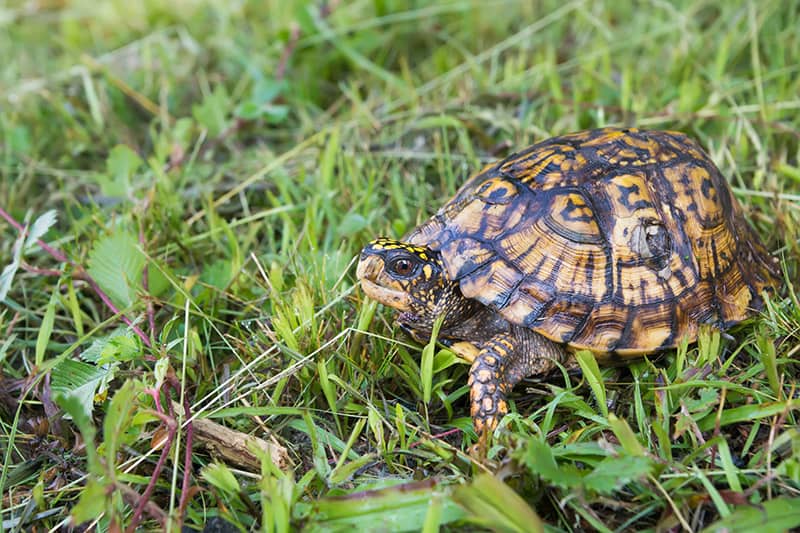
Status
This turtle is listed on the IUCN Red List of Threatened Species: LR – lower risk,.
and listed on CITES: Appendix II. All of the eastern box turtles are protected by law in most states in which they occur.
Description
Box turtles have a highly domed carapace (upper shell) and a hinged plastron (bottom shell) that can be completely shut to keep out predators. These characteristics contribute to this turtle’s descriptive name, ‘box turtle’. Small to medium sized, the eastern box turtles generally range in size from 6 to 7″ (15 – 18 cm) with a maximum of 8″ (20 cm).
The Three-toed Box Turtles is a fairly small turtle reaching from about 4 1/2 to 6″ in length. Overall they are a fairly uniform olive-brown to brown or horn color, though occasionally there will be one that is more brightly colored. They also usually have only three toes on their hind feet, but here again there is an occasional one that will have four toes. They can have some yellowish spots on their skin, and males sometimes have red markings on the head. The plastron on both the male and female is flat.
Males eyes are usually bright red or orange. They also have a somewhat thicker and longer tail than the females, and tend to have hook-like claws on their back feet. The females eyes are usually dark red or brown.
Care and Feeding
Eastern box turtles are omnivores and feed on a huge variety of food in the wild. In captivity, they are especially fond of live food such as earthworms, superworms, redworms, wax worms, crickets, pink mice, and even goldfish.
In addition to this large variety of live foods, you can offer chopped fruits and vegetables. Finely grated dark green veggies such as lettuces and kale, and fruits such as melons, berries, cantaloupe, are also accepted (though not eagerly) once or twice a week.
They will eat MAZURI® Tortoise Diet and high-quality canned cat food (beef, chicken, turkey, etc.), but this should only be a small part of their overall diet. Many keepers choose not to feed cat food as it is high in fat and protein which can lead to obesity and shell deformities.
It is important that these turtles always have access to clean water. A plastic paint tray, large plant saucer, or shallow cat litter pan is placed inside to create a water area. (The plastic paint tray is sloped and so provides a grade that even the smaller turtles can use to get out of the water.) The water in the tray or tub will need to be changed often as the box turtles will soak and defecate in it regularly.
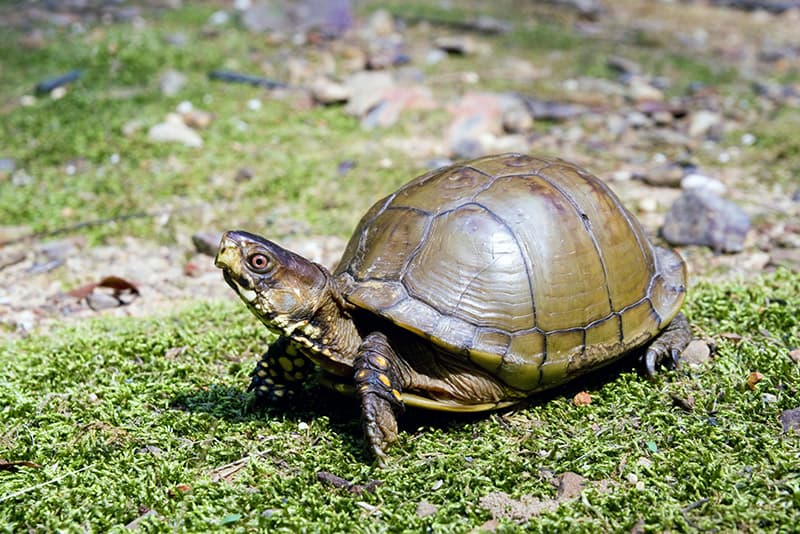
Environment
Indoors
Indoors, these more humidity-loving eastern box turtles can be set up in large tubs (48″ w x 84″ l x 24″ deep) or large terrariums in the 55 to 75 gallon range. Bigger is better. Substrate consists of a mixture of ½ dampened sand and ½ peat moss, but first add about 10″ of pea gravel to the bottom to allow some drainage in this damp system. A top layer of cypress mulch is placed over 75% of the environment to aid in holding in moisture.
Shade-loving plants such as Pothos, English ivy, and Ficus are added and leaves and palm fronds add to the cover. You can use sheets of bark and large slabs of slate resting sturdily on bricks to act as cover for the more shy box turtles. Spray this enclosure heavily about once a week with warm water during the spring and summer and lightly spray it twice a month during the cooler, winter months.
A shop light fixture with UVB-emitting bulbs is set up overhead. Add heat via a clamp lamp fixture with a 100-watt T-Rex Active UVHeat® bulb. The hot spot below this lamp is maintained at 90{deg} to 95 F (32 to 35 C) throughout the spring and summer months.
This setup works well for both the temperate species (Eastern Box Turtle, T. c. carolina and Three-toed Box Turtle, T. c. triunguis) and the tropical species (Florida Box Turtle, T. c. bauri and Gulf Coast Box Turtle, T. c. major).
Outdoors
These active and personable turtles do very well in outdoor enclosures even in areas with hot, dry summers as long as some precautions are taken. Places where summer temperatures can reach 100{deg} F (38{deg} C) in July and August will need to have the enclosure shaded by surrounding trees, shrubbery, ornamental grasses, and plants.
An ideal setup for most temperate areas and that will work year round in warmer climates involves providing an enclosed (fenced-in type) habitat. This enclosed area needs a sunken tub with water and plants in it, surrounded on three sides with grass or a ground cover. In this surrounding area there also needs to be a small patch of soft ground, prepared by digging the soil up and adding some sand, peat moss, and leaf compost.
- For more details on providing an outdoor enclosure for your box turtle, see: Guide to a Happy, Healthy Box Turtle: Outdoor housing
Handling:
As with all turtles, we suggest that keepers keep handling to a minimum. They can be handled when their enclosures are cleaned or when they are moved from indoor enclosures to outdoor enclosures, but they are definitely not hands-on pets. We do suggest, however, that you give them a once-a-month to check for any signs of health-related problems.
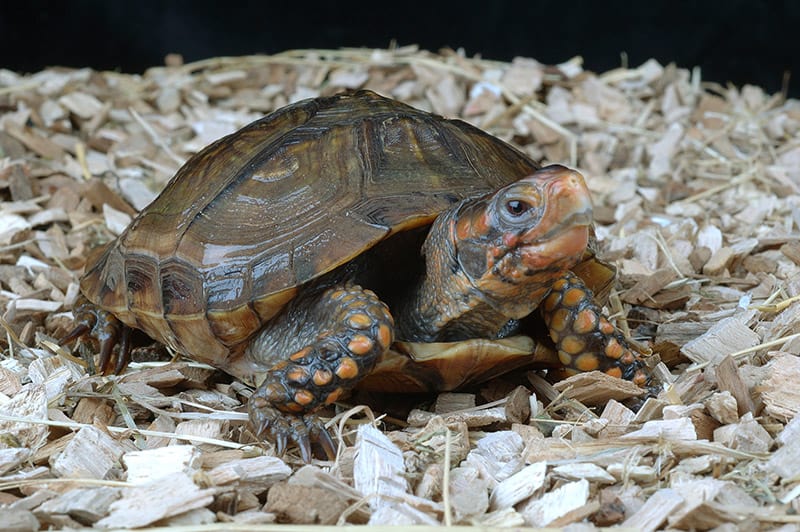
Breeding:
Once established in a secure and healthy environment, eastern box turtles are typically very good breeders. They can be prolific and can produce multiple clutches of viable eggs each breeding season.
Hibernation is the trigger for mating in most species of box turtles. Most temperate species (T. carolina subspecies, some T. ornata) will require a period of hibernation in the 50{deg} to 60{deg} F (10{deg} to 16{deg}C) range. Most box turtle breeders cool the adults of these species for as few as 30 days to as much as 90 days during the cooler months.
Females can lay up to three clutches of from two to ten eggs, depending on the species. The eggs typically incubate for 75 to 85 days at 75% to 85% humidity. Box turtles exhibit TSD (Temperature-dependent Sexual Determination). Eggs incubated at 71{deg} F (22{deg} C) produce males. Eggs incubated at 79{deg} F (26{deg} C) produce a mixed ratio of males and females and eggs incubated at 88{deg} F (31{deg} C) produce females.
- For more information on breeding, hibernating, and caring for the young, see: Guide to a Happy, Healthy Box Turtle: Breeding – Hibernating and Hatchling Care
Interestingly, female box turtles have been known to store sperm and produce viable eggs for up to four years after copulation (Ewing, 1943 and de Vosjoli & Klingenberg, 1995).
Ailments / Health Problems
Like many reptiles, eastern box turtles can be susceptible to illness, disease, and injury. However many ailments are preventable simply from taking proper care of the animal. Be sure to provide your pet with the right type of environment for its needs, keep it’s enclosure clean and maintained, and provide it with a proper diet.
Some ailments that can affect box turtles are respiratory infections, eye-related problems, larvae of parasitic flies, injury, stress, and shell damage.
- For more information on ailments and what to do about them see: Guide to a Happy, Healthy Box Turtle: Ailments – Health Issues
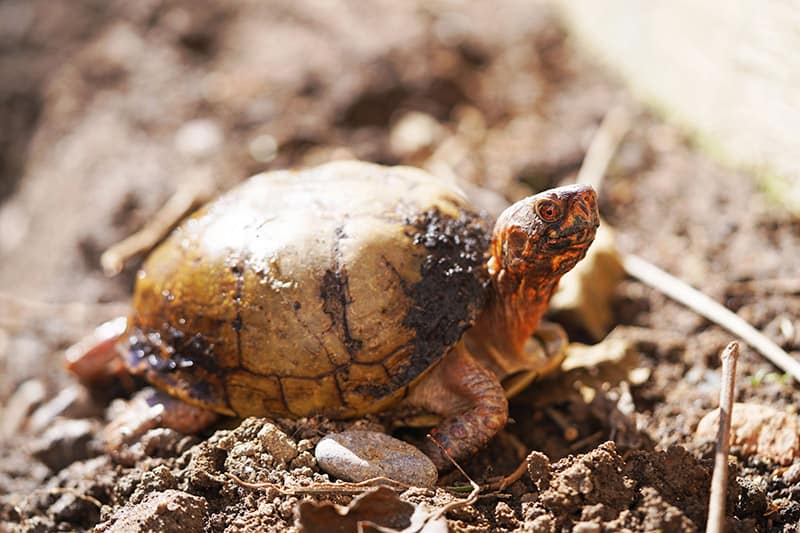
Availability
Three-toed Box Turtles are are rarely available through pet stores, being more readily available at reptile shows and on-line. Many wild-caught specimens, including most Eastern and Florida Box Turtles, are actually sold illegally as they are protected across their range.
Though young box turtles are somewhat delicate and sensitive to husbandry errors, it is very important for hobbyists to purchase captive-produced animals whenever possible. Typically, the many wild-caught box turtles that are available each year do poorly in captivity due to stress, dehydration, and internal parasite issues.
Box Turtles are becoming more commonly available as captive-hatched specimens. Support turtle breeders by purchasing their healthy, captive bred offspring. Some breeders take their offspring to local shows as it is easier (and much better for the delicate hatchlings) to sell them to someone without having to ship them across the country. This is better for the small turtle and better for the keeper.
Watch on-line classifieds for a breeder in your area or attend one of the larger reptiles shows in the country to find captive-hatched box turtles.
Featured Image Credit: micahzeb , Pixabay
